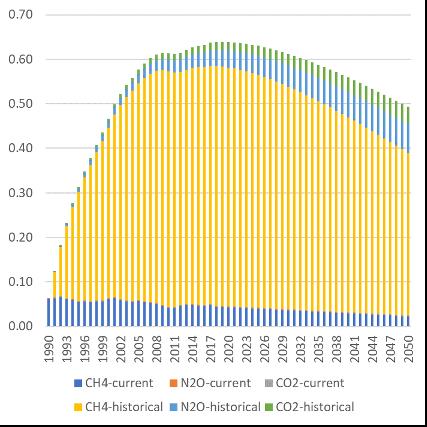Putting more relevant numbers around Australia’s livestock emissions
By James Nason
The Australian red meat industry is getting closer to having some critical numbers to support its case that cattle and sheep are not contributing to global temperature increases as they are often accused of doing by anti-meat activists and plant-based protein purveyors.
Research completed by the CSIRO shows Australia’s sheep meat sector, despite having increased overall production over the past 30 years, is making no contribution to global temperature increases and in fact its impact is trending downward.
It is expected that by mid-2021 CSIRO will have also completed work commissioned by Meat & Livestock Australia that will show the Australian red meat industry’s greenhouse gas emissions measured under the GWP 100 (Global Warming Potential 100) metric and industry emissions measured using the GWP Star metric.
Climate metrics can confound
Despite having become used almost ubiquitously in greenhouse gas assessment, reporting and target setting around the world, the GWP 100 metric is not the most relevant climate metric for use in all policy and decision-making contexts, especially where substantial short-lived emissions, like methane from livestock, are involved.
GWP 100 was the metric adopted by many Governments and policy makers when the Kyoto Protocol was signed in 1997.
It was adoped as a means to allow emissions of all gases to be placed on a common scale of so-called “CO2 equivalence” over a 100 year time horizon, to enable the trading of “carbon credits’’. One carbon credit represents one tonne of carbon dioxide equivalent (tCO2-e) stored or avoided.
However, the GWP 100 accounting metric is also recognised as having significant shortcomings, in that it does not provide an accurate reflection of the effect on global temperatures of short-lived and long-lived gases.
The Carbon Dioxide (CO2) molecule persists in the atmosphere for huneds or thousands of years.
The Methane (CH4) molecule is much shorter-lived in the atmosphere, where it is destroyed through oxidation after 10 or 12 years to produce carbon dioxide and water vapour.
“People talk about CO2 equivalence but there is no absolute equivalence between one gas and another,” Dr Brad Ridoutt, Principal Research Scientist with CSIRO Agriculture and Food, explained to Beef Central in a recent interview.
“Each greenhouse gas has a unique impact on the climate in terms of its strengths and in terms of its duration.”
‘Bathtub analogy’ highlights different gases
Ridoutt uses the “bathtub” analogy to illustrate the differences between long-lived greenhouse gases (such as CO2 and Nitrous Oxide (N2O) )and short-lived greenhouse gases such as methane.
“With CO2 it is like a bathtub with the plug left in – you turn the tap on and the level just keeps growing and growing and growing.
As more CO2 emissions are released, more is added to the accumulating ‘’stock’’ of CO2 in the atmosphere.
“With methane it is like a bathtub but with the plug out. You have got some water going into the bath from a tap and some going down the ain.
Therefore, CH4 is considered to ‘’flow’’ in and out of the atmosphere.
“If the tap is on really strong and it is going slowly down the plug hole it could still keep rising, but if the tap is only on at a ibble and it is flowing quickly down the ain, actually your methane levels are falling.”
Another important point was that methane emissions from livestock are part of a biogenic cycle, as depicted by the Clear Center at the University of California Davis.
A simple explanation is that as grass grows it captures CO2 from the atmosphere. The grass is then eaten by a cow and churned around in its gut, where some of the gas is converted into methane and then belched back into the atmosphere.
As that methane breaks down over the next 10 to 12 years, it degrades into CO2 and water vapour. This is in effect the same CO2 the grass captured before being eaten and belched out as methane a decade or so before.
Emissions from this natural cycle where what is emitted is also offset by what is recaptured has different implications for global temperatures than those created by man-made processes that result in CO2, such as burning fossil fuels.
When fossil fuels are extracted from the earth and burned, the CO2 emissions released into the atmosphere adds to stocks which are constantly accumulating.
Opponents of livestock production tend to aw attention to only what livestock emit, and suggest the story ends there.
But the story doesn’t end there, because that ignores the equally important and balancing contribution of what is recaptured by the same natural cycle under a stable livestock population.
It is also important to recognise that despite being a short-lived greenhouse gas, methane is more effective than carbon dioxide at warming the atmosphere as it absorbs much more sunlight energy. The net effect of the shorter lifetime and higher energy absorption is reflected in the GWP 100 metric. The GWP 100 metric for methane also accounts for some indirect effects, such as the fact that methane is a precursor to ozone, and ozone is itself a greenhouse gas.
Therefore, when considering the impact of the livestock sector on global temperature rise, scientists make the point that it is important to consider the 10-20 year trends in livestock population and consequently, the extent of methane emissions flowing into the atmosphere.
According to Ridoutt, ‘”methane has a separate profile that impacts over a much shorter time”.
“It is much less relevant to stabilising the climate, unless of course you are growing your methane emissions.”
Herds that are relatively stable, falling in size, or even slightly increasing, can in fact lead to a “cooling effect” if the overall methane levels are in decline, Ridoutt said.
Sheep meat sector not contributing to temperature rise
A specific example of this was illustrated in research published by Ridoutt late last year. The study calculated emissions from Australia’s sheep meat flock since 1990, the year Australian’s national carbon accounts began. It ew on annual Australian greenhouse gas emission data from 1990 to 2017 to measure the ‘’radiative forcing’’ footprint of the Australian sheep meat industry.
Radiative forcing is the difference between solar irradiance (sunlight) absorbed by the Earth and energy radiated back to space.

Figure 1: Radiative forcing (RF) footprint for the Australian sheep meat sector: historical 1990-2017 and projected to 2050. Source: Brad Ridoutt CSIRO 2020
The study started with a calculation of the amount of emissions produced by the Australian sheep meat flock in 1990. In 1991 new emissions were added. But at the same time some of the emissions from 1990 had degraded and no longer remained in the atmosphere and were subtracted away. In 1992 new emissions were again added to the total, while the percentage of emissions from 1990 and 1991 that no longer remained in the atmosphere were again subtracted away, and so on.
In effect, the research showed that the radiative forcing footprint of Australia’s sheep meat sector has plateaued over the past 30 years and the industry is no longer adding new radiative forcing, figure 1.
“It has stabilised its radiative forcing so it is no longer iving further temperature increases. The Australian sheep meat industry has already achieved a status of stabilisation, which is consistent with the goal of stabilising global atmospheric temperature,” Ridoutt said.
This is despite the Australian sheep meat sector having made incremental increases in its annual output of live weight since 1990, enabled by improved productivity. If sector productivity continued as it has over recent times, that is improved meat and wool production from the same number of sheep, the sheepmeat industry’s radiative forcing footprint will trend downward, Ridoutt’s research showed.
Beef industry ‘still has a way to go’
Ridoutt said the Australian beef cattle industry “still has a way to go”, and says his research shows methane emissions are rising in the sector. But it was also important to note that the industry’s radiative forcing footprint is very different under different models, such as the GWP 100, and the GWP Star model developed by independent climate scientists at Oxford University.
As Figure 2 from his paper shows, the industry’s radiative forcing footprint is substantially lower under GWP star.

Figure 2: Sector emissions measured by the different metrics of GWP 100 (blue) and GWP star (orange). Source: B Ridoutt CSIRO 2020 Click here to view original source.
Ridoutt’s view is that the Australian red meat industry should be focusing its sustainability efforts on working to stabilise its radiative forcing footprint. In his opinion this is the most relevant goal for the industry to aim for to achieve the temperature-based climate stabilisation goals as expressed in the 2015 Paris Agreement.
“The whole idea of demonstrating no increase to radiative forcing is something I feel is really viable for the industry, it just needs to work towards getting more understanding of the concept,” he said.
“The Paris Agreement (of 2015) is not about reducing all emissions to zero, it is about stabilising climate, it is accepting the fact that we’re not going to get back to the pre-industrial era, it is about stopping the climate from racing out of control.”
“The sooner every industry can get to that, the temperature will stop rising and if we can do it soon enough we will stay within the IPCC’s 1.5 degree global temperature rise limit.”
Pathways for farmers to reduce their radiative forcing profile included using renewable energy and soil carbon sequestration.
MLA Manager – Sustainability Innovation, Doug McNicholl, said it was important for the Australian red meat industry to be able to get the “numbers on the table” so it could compare, contrast and communicate the industry’s position using both the GWP 100 metric which is the IPCC and the Australian Government’s adopted method and using the GWP star metric.
“Our stakeholders want MLA to report numbers using multiple metrics, and we are working on that with the CSIRO,” Mr McNicholl said.
Retailers want evidence of reducing livestock emissions
Separate to the issue of how emissions from Australian livestock are accounted for and reported is the issue of what the Australian industry is doing to reduce greenhouse emissions and improve carbon storage alongside profitable livestock production.
In 2017 the Australian red meat industry launched the Carbon Neutral 2030 initiative to coordinate a range of approaches throughout the red meat supply chain to reducing emissions and increasing carbon stocks.
Mr McNicholl told Beef Central that some of the world’s largest red meat retailers are “asking for the numbers” and engaging suppliers in climate action. This included Walmart which has set a goal to reduce 20 million metric tonnes of greenhouse gases from its supply chain under its “Gigaton Project”.
“An opportunity exists for the Australian red meat industry to secure ongoing market access and even grow the value of sales through promotion of environmental stewardship practices enabled through livestock production,” he said.
Ridoutt said the red meat industry also had to be mindful about practices that reduced methane but effectively increased carbon dioxide and nitrous oxide output at the same time.
Feeding grain to animals was one example, in his opinion.
“In the feedlot you reduce your methane by growing them faster, but how are you doing that? By feeding them more crops, and those crops have got CO2 and N2O associated with their production, that is one obvious example.
“A lot of things that involve making the industry more efficient and reducing methane involve using more intensive use of fuels and fertilisers and irrigation.”
It is worth noting that the same issue applies to plant-based proteins which are often touted as a more environmentally-friendly alternative to red meat, but which face a major challenge to demonstrate net zero CO2 and N2O emissions.
Source: Beef Central 24 March 2021. To subscribe visit www.beefcentral.com



